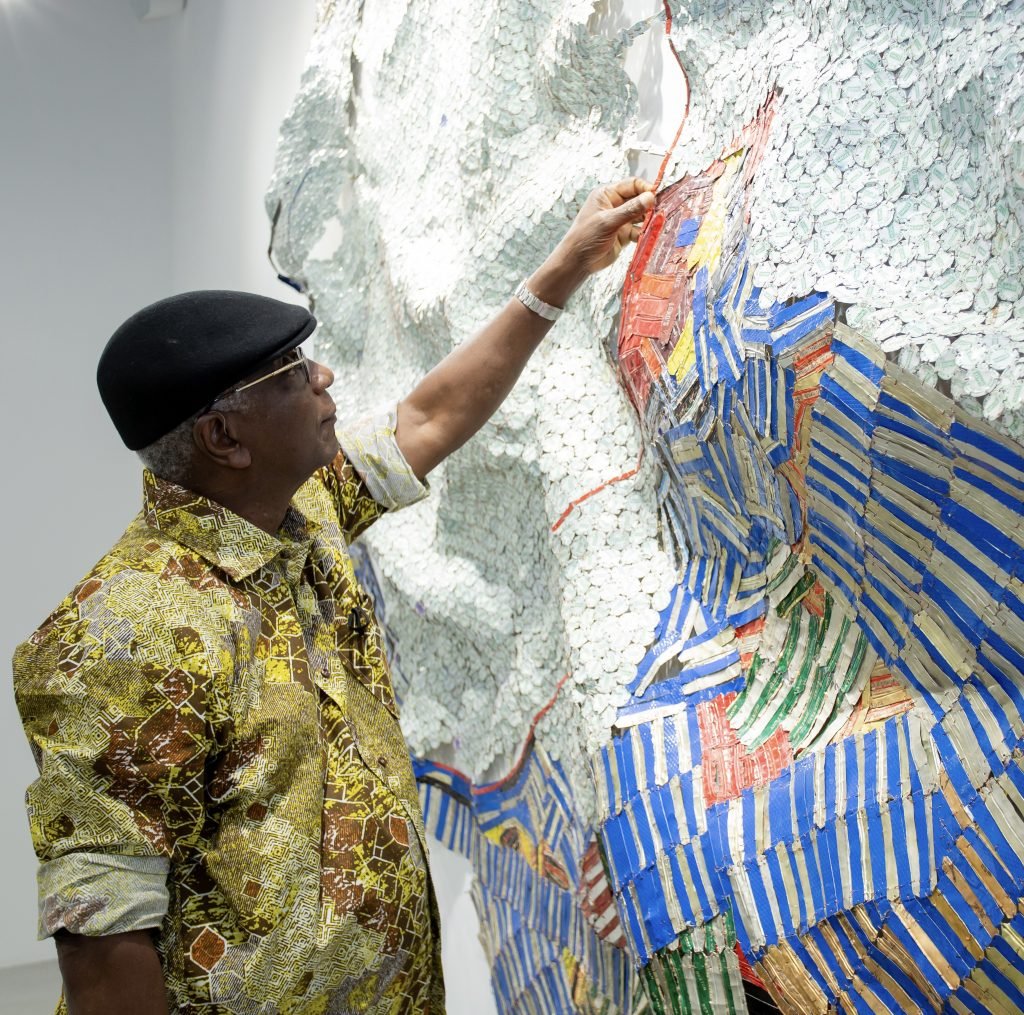One could call El Anatsui the godfather of the artistic scene that has erupted in Ghana in the last decade. At 79 years old and now a household name on the world stage, it seems that the sky is the limit for the Nigeria-based Ghanian artist. Already this year, Anatsui was named one of this years’ Time 100 most influential people and, in October, he is due to install the acclaimed Hyundai Commission in London’s Tate Modern’s turbine hall.
Most famous for his large works created from bottle tops beaten flat and linked to look like delicate sheets of precious metals, Anatsui also works in wooden sculpture and prints; their repurposed materials carry with them a weight of history that transcends their aesthetic beauty. The bottle caps—detritus from drinks sold and imported to Ghana and Nigeria—comment on consumption, waste, and geopolitics. The wooden plates he creates his prints with are the same he uses for the flattening of the bottle tops and visibly carry the trace of this process.
Ahead of his major show at the Tate this fall in London, Artnet News spoke to the artist about his relationship to scale and the increased attention on in the Ghanian art scene, including what this means for the upcoming generation of African artists.
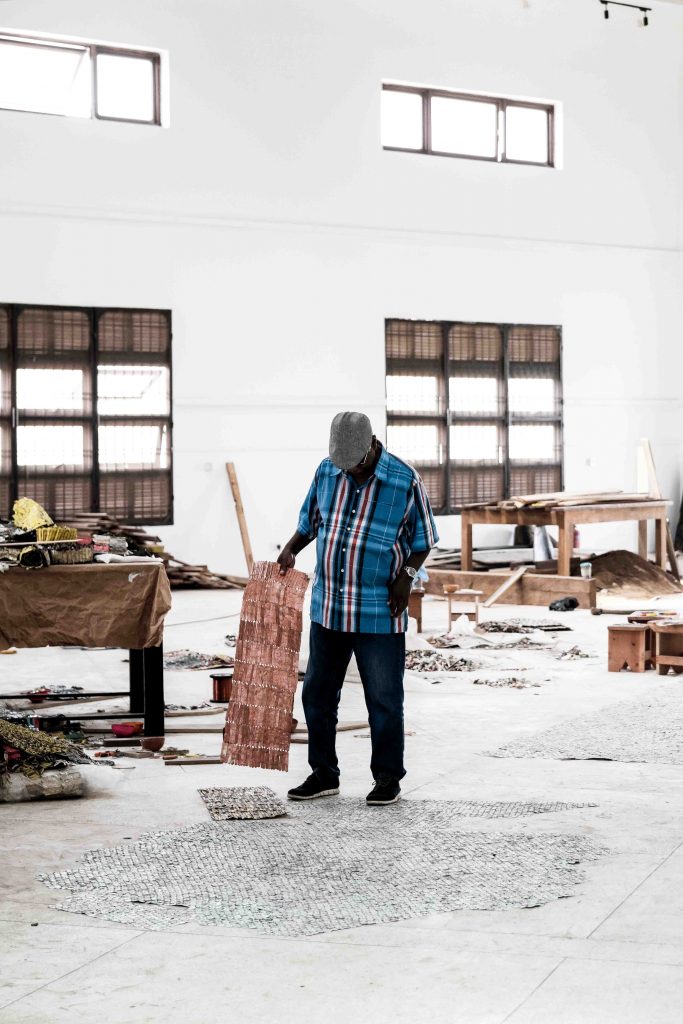
El Anatsui in the studio. Photo: Ofoe Amegavie
You seem to be having a great year: you are working towards the Tate Hyundai Commission, which means you will be taking over this year’s Turbine Hall installation at London’s Tate Modern this fall. You were also included among the Time 100′s most influential people. How does that feel?
Being one of the people chosen to be [on Time‘s list] was a good feeling. What one is doing is being recognized, at least by some people. If Time recognizes you, I think it means something.
Do you think that the increased awareness around the non-Western canon has broadened people’s understanding of your work?
If there’s anything happening, it is building on what happened when cultures met during the European modern art period—when the likes of Picasso saw works of art from other parts of the world, including Africa. They were astonished by what they saw. Eventually the world started to bend to where the world is now and it started getting smaller. Information, including images and ideas, began circulating all over the world. There is a kind of sort of cross-fertilization of ideas, which has been happening for a long time.
What draws you to work with used objects and what do you think we can learn from them?
I think that used objects have a life which is also continuous.
Long ago, when I was in high school, we were working with new, fresh materials which had no history or anything behind them. Over the course of my practice, I discovered that used materials have more potency. They have a lot to say and this in turn can be your starting point. That is the reason I hardly ever use any material from art shops.
There are things in the studio that I have had since first started working which I’ll pick up and use now. It’s a cycle which has no end because I’ve always believed that art is not about a particular moment but about continuity, a continuum of moments.
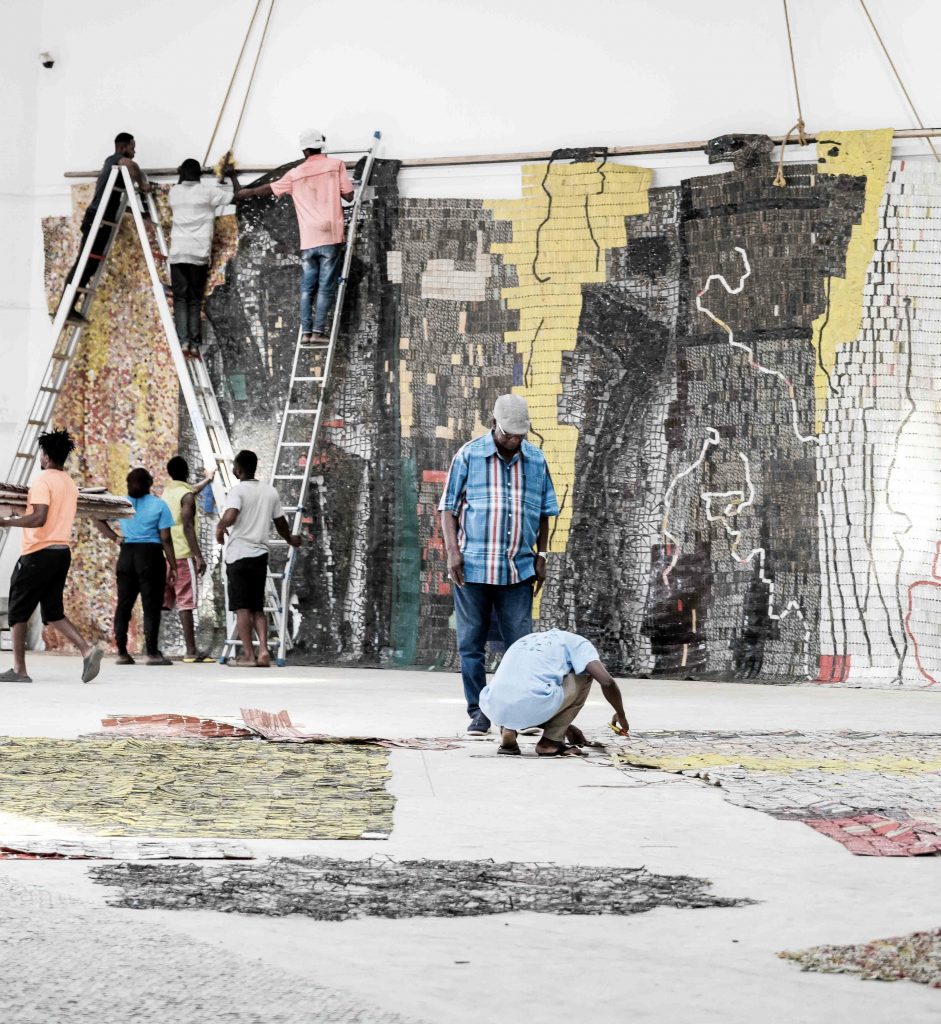
El Anatsui in the studio. Photo: Ofoe Amegavie
What are your views on where we are when it comes to decolonization in the art world?
Well, I wouldn’t want to dwell on the idea of decolonization because it is a word which has lost meaning.
I think we can learn from a meeting of cultures. In most cases, you find that in Europe and the Western world people are concerned with a linear progression from one period to another. But in other parts of the world, including Africa, you might see that whatever is happening in the West now happened in other places. Take conceptual art for example. In the Western canon, it’s dated to very recently, whereas I would say the first instance of conceptual art that I know of happened at the founding of ancient Mali in 1235.
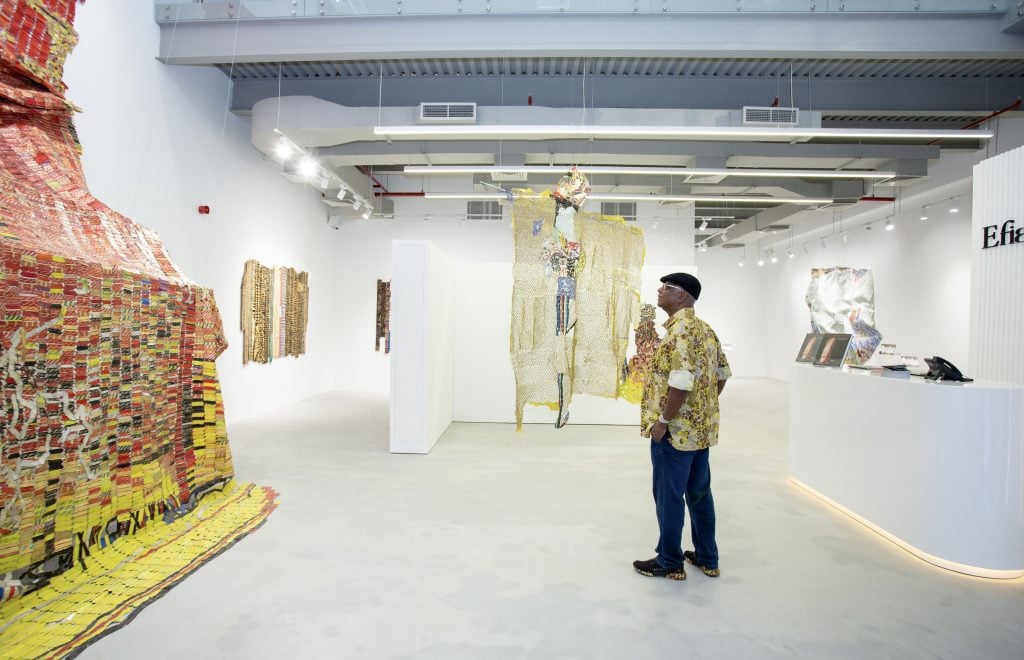
El Anatsui at Efie gallery in Dubai. Photo: Moz Photography
You have created some monumental works and you have also made some lesser known small works. What is your relationship with scale?
I started from my garage in Ghana. It was a very small car garage. The things I made at that time were little things which I would assemble into something larger. The idea of scale grew from that point, because if you’re putting little things together, chances are you can put so many of them together that you will get something much larger.
I left the garage and I acquired a house, which wasn’t completed. I could spread out more—both physically and in my imagination. I had more room to grow. From there, I rented an even bigger space and eventually bought a warehouse and made a purpose-built studio. With each of these [transitions], the space became bigger. I realized that the space sizes were commensurate with the sizes that I worked with. The bigger, the better!
I’m able to do many things at once and works can play off each other and help each other to grow, just like human beings. If you’re alone, you can’t do much and you can’t achieve much, but other people can help each other and can find solutions to a lot of your problems.
Amoako Boafo and Kwesi Botchway are two artists who have recently opened artist residencies in Accra, Ghana. Is this something you have considered?
We are actually in the process of setting up a residency. We had the first pair of resident artists last year. Initially, we had artists come try it out and, based on that experience, we’re trying to develop the facilities and amenities. When future artists come to take part, there will be more equipment, materials, ideas, and people to work with.
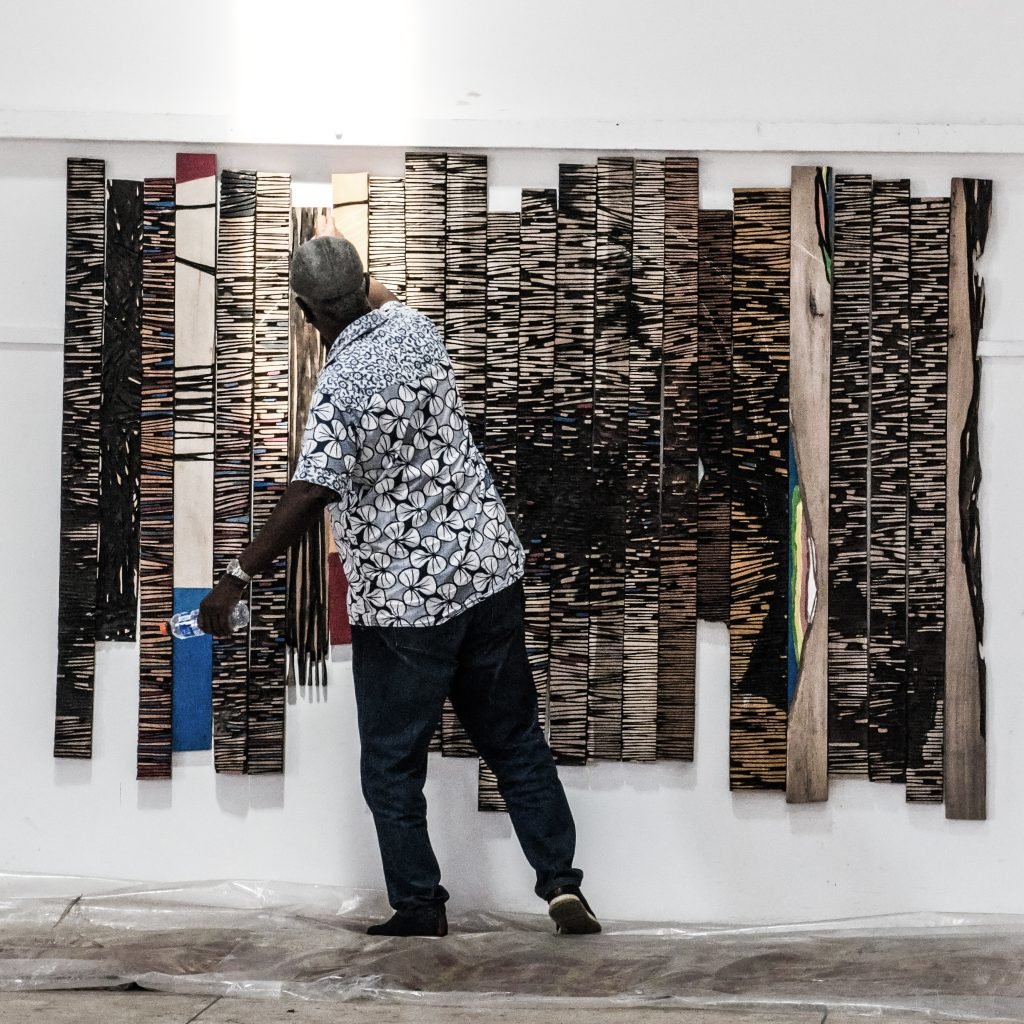
El Anatsui in the studio. Photo: Ofoe Amegavie
What has it been like to see the scene grow in Ghana over the last 20 years?
I am really happy about what is happening in Accra. A lot of younger artists are getting recognition very early in their career and moving things forward. They are going to build the art scene far better than that of my generation, who did, however, clear a path.
If you clear a path, you expect people to use it, and this means more people can move forward in order to search for what you’ve been searching for and do it faster.
Is there anything that you would say to these younger artists, as they’re coming up, or is the clearing of the path enough?
If the path is cleared, it’s expected that you don’t just use that path alone. It’s meant to open up the terrain so that you can go and open more paths. I think everybody should be opening paths and, at the end of the day, we’ll have so many that it will be easy for the next generation to have the chance to operate at a global level.
You envisage the scene having an international connection?
Yes, a world connection in such a way that it’s not one-way traffic, where you have people from all over the world and from the West coming to the so-called South because there are things to discover.. [T]o come and to learn something from.
More Trending Stories:
The Brooklyn Museum’s Much-Criticized ‘It’s Pablo-matic’ Show Is Actually Weirdly at War With Itself Over Hannah Gadsby’s Art History
A Collector Clinched a Rare 17th-Century Terracotta Sculpture for a Record $2.85 Million at a French Auction. Now, the Louvre Is Snatching It
This Famed Dollhouse Is Hung With Tiny Original Artworks, Including a Miniature Duchamp. Here Are Three Things to Know About the One-of-a-Kind Treasure
A Writer Is Calling Out the British Museum for Using Her Translations of Chinese Poetry in an Exhibition Without Permission
The Venice Biennale Has Announced the Highly Anticipated Curatorial Theme of Its 2024 Art Exhibition
A Couple Renovating Their Kitchen in Denmark Found an Ancient Stone Carved With Viking Runes
Rubens Painting Lost For 300 Years and Misidentified When Last Sold at Auction Will Star At Upcoming Sotheby’s Sale in London
